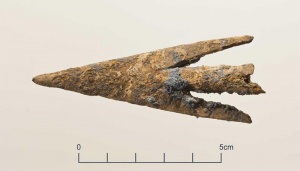Rare artefacts unearthed along Thameslink London

Medieval floors, 16th century tobacco pipes and thousand-year-old timbers are just a few of the hundreds of artefacts that have been unearthed and preserved by Network Rail as the £6.5billion Thameslink Programme to transform travel to and through London continues with the rebuild of London’s oldest railway station, London Bridge.
Archaeological work during construction of the new Borough viaduct uncovered remains from the Roman, Saxon, medieval and more recent periods that provide a fascinating insight into the formation and growth of the ancient settlement at Southwark.
A rare 14th century flagon, thought to have been used to serve ale in the Abbot of Waverley’s town house, is now on display in The Wheatsheaf Pub in Stoney Street, close to where it was excavated during the installation of the Borough viaduct.
“We believe from its distinctive white clay that it was made in Cheam between 1350 and 1440,” said Jackie Keily, curator at the Museum of London, which gave permission for the jug to be displayed in The Wheatsheaf.
Nicky Hughes, head of communications for Network Rail, London and South East, said: “The £6.5bn Thameslink Programme is transforming rail travel north and south through London to provide more space, better connections and a rebuilt London Bridge with more space and great facilities. As one of London’s oldest stations it’s not surprising that we are unearthing such a range of interesting finds shedding light on London’s development through the ages.
ADVERTISEMENT
“Above us the Station is still serving 52m passengers a year but underneath them we are unearthing all this amazing archaeology as we construct a brand new concourse the size of Wembley Stadium. We are working hard to keep London’s oldest station open whilst completely rebuilding it”.
During the excavation of the original brick arches at London Bridge station, hundreds of historic items have been found which give an insight into the first settlement in the area. Timber piles constructed from trees felled between AD59 to AD83 were discovered and may have formed part of a substantial waterfront building on the edge of the settlement south of the first London Bridge.
Fragments of medieval floors and walls have also been found. These could have have been part large houses along Tooley Street , known to have belonged to important clerics such as the Prior of Lewes. More recent discoveries, dating from the 16th to 18th centuries, include evidence of industry in the area such as kilns for making clay tobacco pipes.
Other finds include:
Traces of early Roman military occupation
Evidence for the Boudican revolt
A previously unknown Roman bathhouse under Borough High Street
Substantial evidence for the Saxon/medieval defences of the settlement
The remains of townhouses of important medieval clerics and the St.Saviour’s/Park Street burial ground
The results of the work are currently being analysed by archaeologists from Oxford Archaeology and pre-Construct Archaeology for future publication. All the finds and records will be deposited with the Museum of London at the completion of the work.

